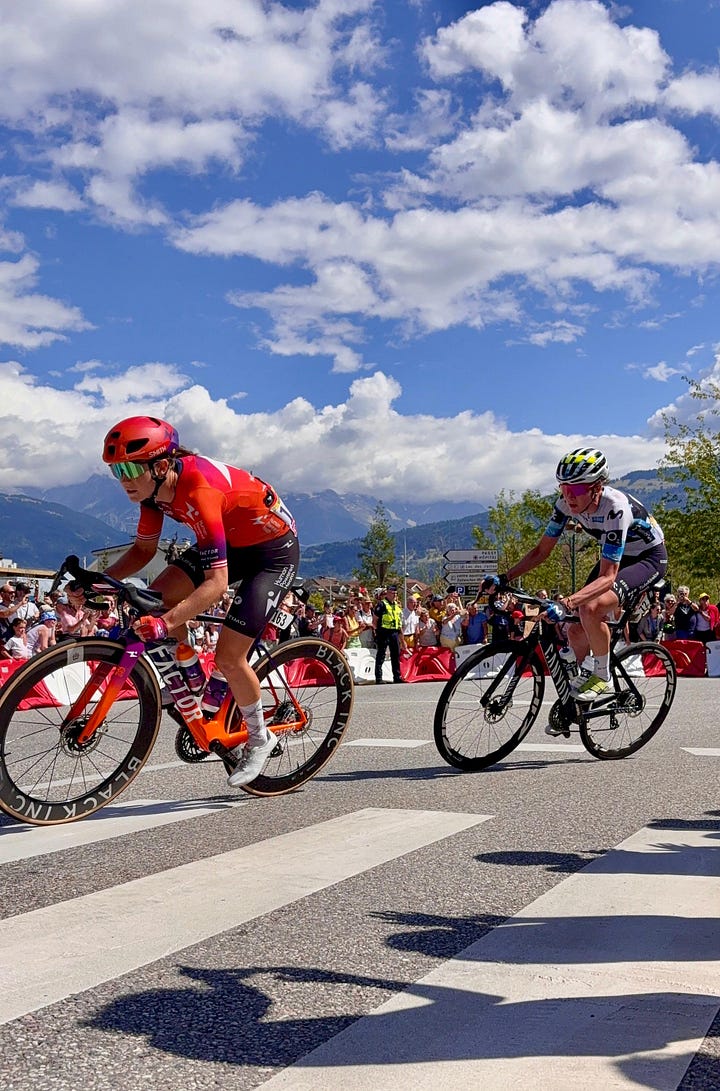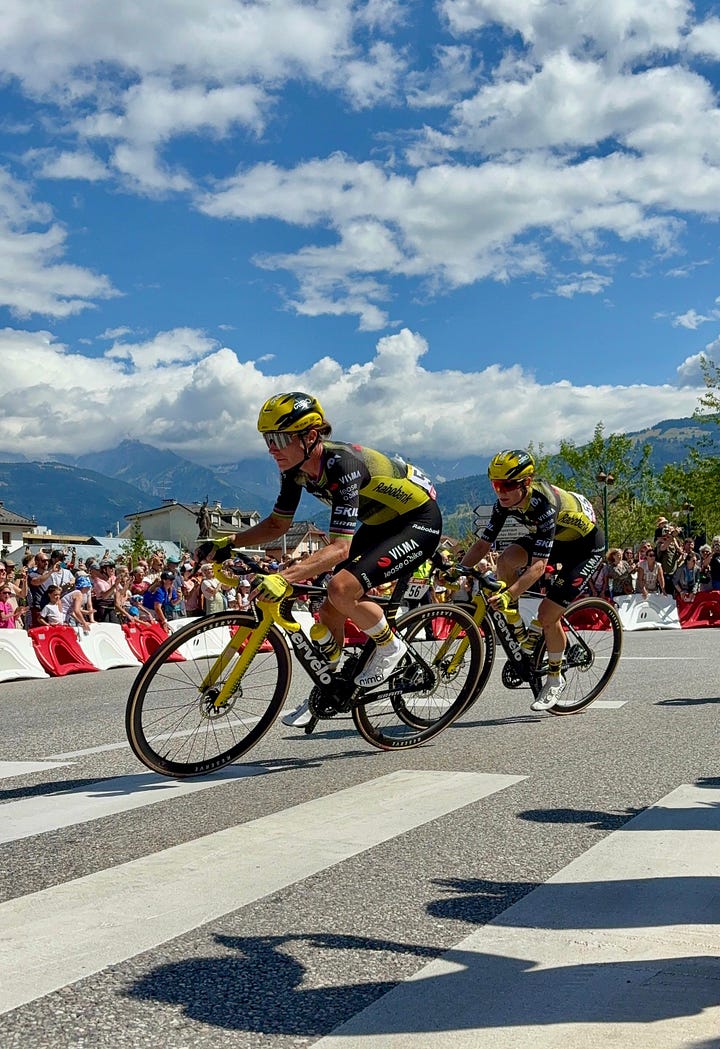'Weighing In' on the Most Exhausting Part of the Tour de France Femmes
It's 2025, and the public is still obsessed with women's weight, even at the highest level of professional cycling
A slightly longer post, because I have a lot of thoughts on a subject I am very passionate about.
The Tour de France Femmes wrapped up last Sunday, and although there is a lot to celebrate about the fourth edition of the cycling stage race, there’s a big shadow hanging over the race coverage. We should be hyping up the massive viewership, with close to 26 million people tuning in, the epic battles for each stage win, and how far women’s sports have come in recent years. And yet—largely because it is, in fact, a femmes race—unsolicited opinions on riders’ weight pervaded media coverage, social media commentary, race interviews, and live commentary during the race.
Even before she took the yellow jersey, race commentators, journalists, and fans could not stop talking about race winner Pauline Ferrand-Prévot’s weight. She was noticeably more leaned out than when she won Paris-Roubaix Femmes in April—a grueling cobblestone race in northern France—and during her preparation for the Tour de France, Ferrand-Prévot made several references to getting down to “race weight” before the Tour.
“Everyone prepares the way they want. For Roubaix I was much heavier because I knew I needed to be heavier to have power on the flats,” Ferrand-Prévot said during a press conference after clinching her Tour de France victory. “For this race I knew I had to climb for one-and-a-half hours over the Col de la Madeleine, and I tried to make the most of it. You need to adapt to the terrain you have.”
Yes, cycling relies on maximizing a good power-to-weight ratio, but emphasizing weight loss as an essential step to winning a Grand Tour is a slippery slope. Cycling is a power sport, and you need proper strength to be able to perform. I couldn’t help thinking about all the young girls watching the most-televised event in women’s cycling and thinking that to be the best, they have to be the lightest version of themselves.


Aside from the problematic idea that women have to lose weight—inherently underfueling—to perform, the other issue with the dialogue circulating around the Tour de France Femmes is the outside obsession with riders’ weight. Women’s sports have seen so much progress in recent years, and the successful resurrection of the Tour de France Femmes is a major testament to that. Yet, when we watch these athletes crushing a high-intensity eight stage race and performing at the highest level, somehow, many of the conversations still focus on how women in the pro peloton look.
Demi Vollering, a rider for FDJ-Suez who took second place in this year’s edition, was asked in an interview by Dutch journalists if she thought that she needed to lose weight to win the race in the future. I don’t recall a single journalist asking Jonas Vingegaard if his weight was the reason that Tadej Pogacar dominated the men’s race this year.
“I don’t want to be skin over bone,” Vollering responded. “I just really hope in the future I can win climbing races again with my heavy weight, and that I can show girls that you don’t have to be super super skinny, and that you can believe that if you have the power, you train hard, you can make it.”
Even at the top level, women can’t even perform without people policing and talking about their bodies. It’s exhausting.
The rhetoric around weight in the women’s peloton is especially dangerous when relative energy deficiency in sport (RED-S) is so prevalent in professional cycling. RED-S develops with chronic low energy availability (LEA)—essentially when you are not fueling enough to meet your body’s energy demands. For women, the loss of a regular menstrual cycle is one of the biggest red flags. Although people, especially endurance athletes, sometimes see short-term performance gains linked to a lower body weight, the temporary gains are basically a ticking time bomb. Eventually, your body will say, enough.
Without changes, secondary amenorrhea can lead to depression, low bone mineral density, and serious cardiovascular issues. Chronic amenorrhea is also linked to early onset Alzheimer's. Even in the short term, RED-S can cause insomnia, lower immunity, anxiety, decreased endurance, increased injury risk, and low libido. Although RED-S is reversible, it requires a lifestyle overhaul: increasing food intake and, usually, decreasing exercise for a significant amount of time. Without major changes, the effects can be devastating.
In an Instagram post after the Tour, Vollering wrote that “around 80%” of the questions that she received at the final press conference were about her weight. “The truth is: I’m not built to be the lightest rider in the peloton. And I don’t want to force my body to become something it’s not. I’m already racing at the highest level—with a strong, lean, capable body,” she wrote.
Vollering goes on to add that she’s speaking out because of the potentially harmful beliefs circulating that to be the best athlete you have to be the lightest.
“Young girls are watching us. They notice what we say—and what we don’t. What we show. What gets celebrated as ‘the way’ to succeed. Sometimes, what they see quietly plants a seed. They might not talk about it. Or even realise it’s becoming something harmful. That’s why we—as high performance athletes, teams, and a sport—have a responsibility. We must create safe environments where athletes can ask questions, speak openly, and get the right guidance—especially young and developing riders. Because the risk is real. Because health isn’t always visible. Because disordered thinking can grow quietly and stay hidden for a long time.”
Other riders are speaking out as well. Cédrine Kerbaol, a French rider for EF-Education Oatly, said that cycling is “in a dangerous moment.”
“There are many people who have won major races with very low weights, and indirectly, young girls trying to perform well will see them as examples,” Kerbaol told French newspaper L’Humanité. “We have reached the point where girls think that being very thin is the right example to follow. But it's not normal to have decalcified bones at 20; it's not normal to stop having periods. Above all, we don't want to blame anyone, but to set an example.”
Kerbaol, who has a diploma in nutritional studies, also created an Instagram account, Fueling for Endurance, Energy, and Durability: @f.e.e.d_powr, two months ago to help educate athletes about proper nutrition for both health and training. In one video, Olympic champion Kristen Faulkner breaks down how she prioritizes health and performance, respecting her body’s demands.
“I never would have won two Olympic gold medals, let alone one, if I had tried to optimize for being the skinniest version of myself. I needed to optimize for being the strongest, healthiest Kristen," Faulkner said. “If I had tried to optimize for somebody else’s ideal body type, I never would have achieved my biggest accomplishments in my career.”
For people watching at home, especially young girls, hopefully athletes like Vollering, Kerbaol, and Faulkner show that you can excel at the highest level without sacrificing long-term health. And, please, let’s stop talking about how women in the pro peloton look, and focus instead on the exceptional athletic feats they are completing.
For more support and resources, check out Project RED-S, which just released a new awareness video “for every athlete who’s felt lost, unsupported, or confused by what’s going on in their body,” featuring two-time Olympian Elise Cranny and 2020 U.S. Olympian Jake Reilly. Stanford FASTR (Female Athlete Science and Translational Research) is also doing incredible work. Led by Dr. Emily Kraus, FASTR aims to close the gender gap in sports science research, focusing on injury prevention, healthy fueling, and identifying tools to optimize performance in female athletes, starting from a young age.




